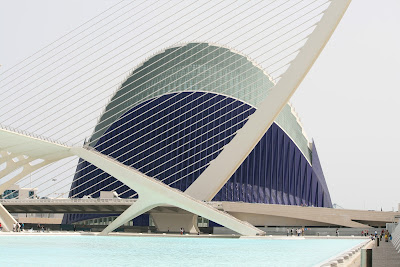People come to Barcelona will not miss the great architectures of Mr. Gaudi. One of his famous project is the Basilica of the Sagrada Familia. Construction work of the church has been carried out over a century. The complex project is expected to take few more decades before reaching its completion. With great devotion and hard work, Gaudi and his team are putting together a historical master piece.
 |
| (The Nativity Facade of the Basilica from the garden pond) |
 |
| (Closer look at the Nativity Facade) |
 |
| (The Passion Facade) |
 |
| (Close up at the Passion Facade) |
Gaudi was under the influence of Gothic Revival in the 19th century. He also made reference to Moorish momentums in Spain. Gaudi later moved towards modernisme and found great imagination from the nature.
 |
| (Entrance to the Park Guell, another work of Gaudi in Barcelona) |
 |
| (The Dragon in the entrance staircase of the Park) |
Valencia is a city of gardens. It has both modern and historical architectures covering the beautiful city. Personally, I find Valencia as the most attractive modern city in Spain.
 |
| (The L'Hemisferric and the Palau de les Arts Reina Sofia - part of arts, science and cultural complex in Valencia) |
 |
| (The Agora behind the L'Assut de l'Or bridge) |
Inside the old Valencia city, Gothic churches, city buildings and gardens mix well and provide citizens peaceful lifestyle.
 |
| (The Plaza de la Reina in front of the Valencia Cathedral) |
 |
| (The Plaza del Ayuntamiento, Valencia's main square) |
 |
| (Valencia train station - Estacio del Nord) |
 |
| (Mosaic of the Virgen de los Desamparados, the patron Saint off Valencia) |



















